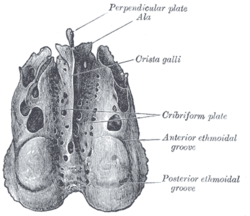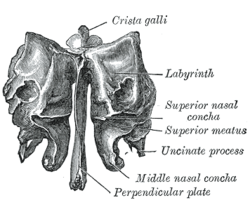Crista galli
| Crista galli | |
|---|---|
 Ethmoid bone from above. | |
 Ethmoid bone from behind. | |
| Details | |
| Part of | perpendicular plate of the ethmoid bone |
| System | skeletal |
| Identifiers | |
| Latin | Crista galli |
| TA98 | A02.1.07.004 |
| TA2 | 724 |
| FMA | 57442 |
| Anatomical terms of bone | |
The crista galli (Latin: "crest of the rooster") is the upper part of the perpendicular plate of the ethmoid bone of the skull. It rises above the cribriform plate. The falx cerebri (a fold of the dura mater surrounding the brain) attaches to the crista galli.
Structure
The crista galli is the upper part of the perpendicular plate of the ethmoid bone of the skull.[1] It rises above the cribriform plate.[2] The falx cerebri (a fold of the dura mater surrounding the brain) attaches to the crista galli. The olfactory bulbs of the olfactory nerve lie on either side of the crista galli on top of the cribriform plate.
Variation in Morphology
The base of crista galli varies in height.[2] A retrospective study of CT data from 2007 to 2009 reviewed scans of 99 people. The results showed that in 63.6% of subjects the base extended less than 50% below the height of the cribriform plate.[2] In 28.3%, the base did not extend above the cribriform plate, while in 8.1%, the base extended more than 50% of the CG height below the top of the cribriform plate.[2]
History
The term "crista galli" is Latin for "crest of the rooster".
References
- ^ "Ethmoid bone". www.anatomynext.com. Retrieved 2018-03-01.
- ^ a b c d Hajiioannou, Jiannis; Owens, David; Whittet, Heikki B. (2010). "Evaluation of anatomical variation of the crista galli using computed tomography". Clinical Anatomy. 23 (4): 370–373. doi:10.1002/ca.20957. ISSN 1098-2353.
External links
- MedEd at Loyola Radio/curriculum/ENT/jay84a.jpg
- Floor of the cranial cavity (close-up)[dead link] - BioWeb at University of Wisconsin System
- "Anatomy diagram: 34257.000-2". Roche Lexicon - illustrated navigator. Elsevier. Archived from the original on 2014-01-01.
- Cross section image: skull/x-front—Plastination Laboratory at the Medical University of Vienna
